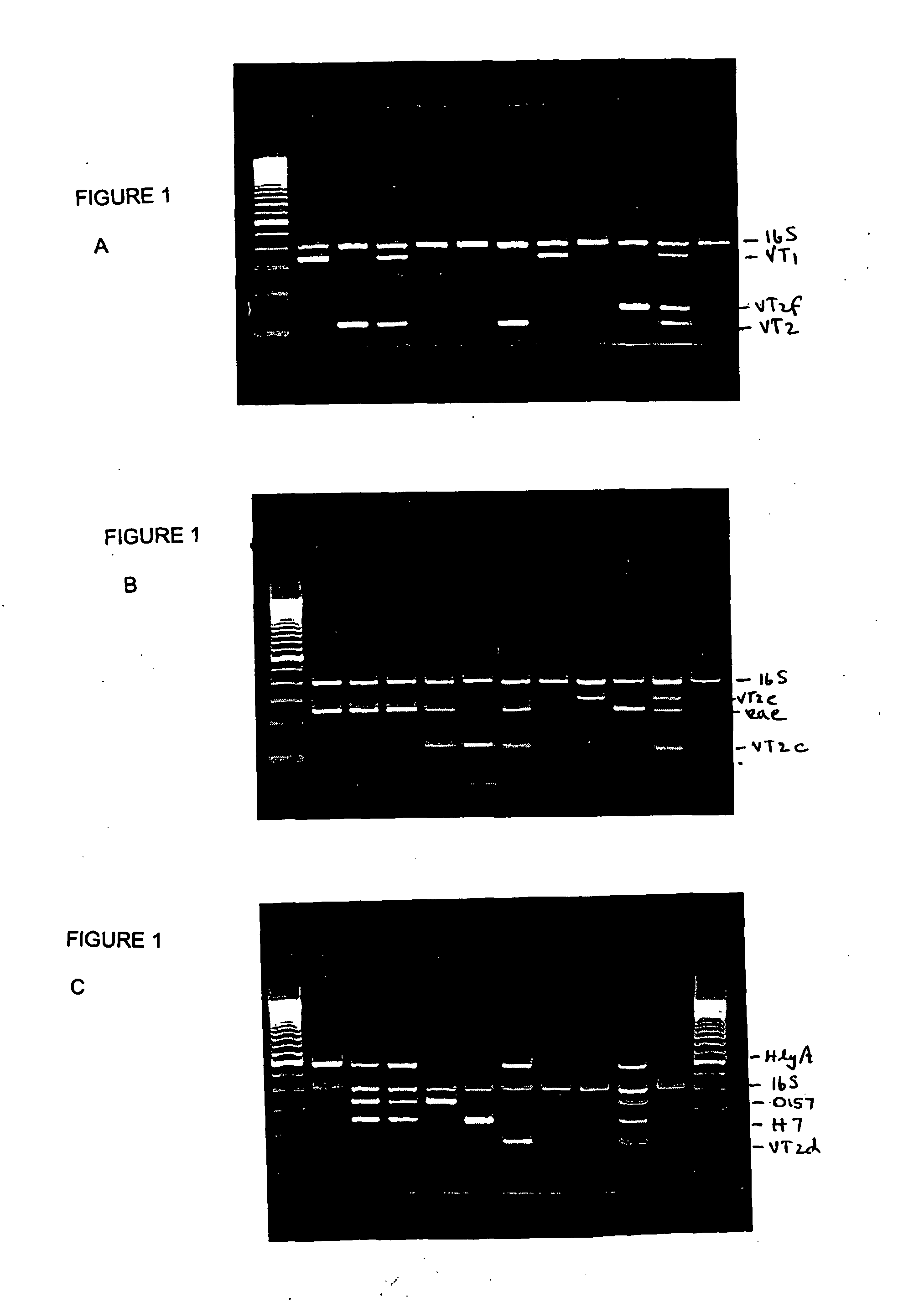Major virulence factor detection and verocytontoxin type 2 subtype from clinical e. coli isolates using a one-step multiplex pcr
a multi-step, e. coli technology, applied in the field of pathogenic organisms, can solve the problems of life-threatening complications, no specific treatment, and difficulty in distinguishing between vt2 variants using pcr alon
- Summary
- Abstract
- Description
- Claims
- Application Information
AI Technical Summary
Problems solved by technology
Method used
Image
Examples
example i
Bacterial Strains and Culture Media
[0084] A total of 129 E. coli isolates from the culture collection of the National Laboratory for Enteric Pathogens (NLEP) were used in this study and included: 79 E. coli O157:H7, 5 O157:NM (non-motile), 7 O157:non-H7 (one each of O157:H10, H19, H21, H43, H45 and 2 H16), 12 non-O157:H7 (2 O27:H7, 3 O18:H7, 5 O55:H7, 1 each of 156:H7 and O83:H7), 6 non-O157:NM (1 each of O1:NM, O7:NM, O91:NM, OR(rough):NM and 2 O111:NM), 14 non O157:non-H7 (1 O6:H1, 2 O103:H2, 1 O146:H21, 1 O26:H11, 1 O70:H11, 1 O91:H21, 1 O139:K82, 1 O128:B12 and 1 O15:H27, 2 O128:H?, 1 O113:21, 1 OR:H21), 3 O UT(untypable):H7, 1 O UT:H8 and 2 O UT: H UT. Of these, 101 strains were VTEC and 28 were VT negative. The control strains had been previously defined in terms of virulence factors and toxigenicity with respect to VT1, VT2, VT2c, VT2+VT2c, VT2d, VT2e, VT2f, eaeA and EHEC-hlyA (Table 1).
example ii
DNA Isolation
[0085] Total DNA was isolated from 0.5 ml of brain heart infusion broth culture grown overnight for all the bacterial strains used in this study. The procedure used for DNA isolation was described in Tyler et al., 1991, J Clin Microbiol 29: 1339-1343, which is incorporated herein by reference. DNA samples were dissolved in Tris-EDTA buffer (10 mM Tris, i mM EDTA [pH 8.0]), and the concentration was determined in μg / ml at an optical density reading of A260. Template DNA concentration used was 2 μg / ml.
example iii
Primers
[0086] Oligonucleotides ranging from 19 to 25 mers were selected as described above. Synthesis of oligonucleotides was carried out at the DNA Core Facility at the National Microbiology Laboratory, Winnipeg, Canada. As discussed above, for multiplex PCR, 3 primer sets were prepared: Set A which was designed to amplify VT1 (VT1-a / VT1-b), VT2 (VT2-a / VT2-b), VT2f (VT2F-a / VT2F-b) and 16S rRNA; Set B which was designed to amplify VT2c (VT2c-a / VT2c-b), VT2e (VT2e-a / VT2e-b), eaeA (EAE-a / EAE-b) and 16S rRNA; and Set C which was designed to amplify VT2d (VT2d-a / VT2d-b), EHEC-hlyA (HlyA-a / HlyA-b), rfbE (rfbE-a / rfbE-b), flic (flic-a / flic-b) and 16S rRNA. The primer sequences are described above and in Table 2.
PUM
| Property | Measurement | Unit |
|---|---|---|
| concentration | aaaaa | aaaaa |
| restriction fragment length polymorphism | aaaaa | aaaaa |
| time | aaaaa | aaaaa |
Abstract
Description
Claims
Application Information
 Login to View More
Login to View More - R&D
- Intellectual Property
- Life Sciences
- Materials
- Tech Scout
- Unparalleled Data Quality
- Higher Quality Content
- 60% Fewer Hallucinations
Browse by: Latest US Patents, China's latest patents, Technical Efficacy Thesaurus, Application Domain, Technology Topic, Popular Technical Reports.
© 2025 PatSnap. All rights reserved.Legal|Privacy policy|Modern Slavery Act Transparency Statement|Sitemap|About US| Contact US: help@patsnap.com

